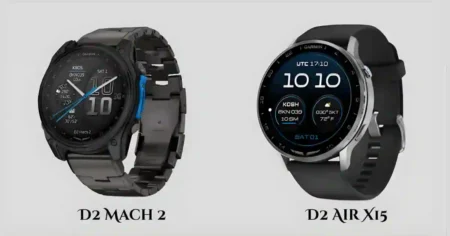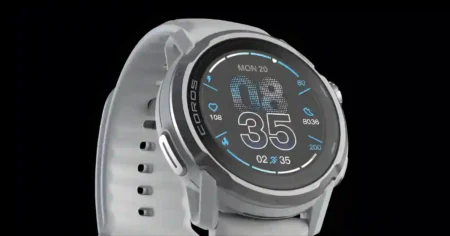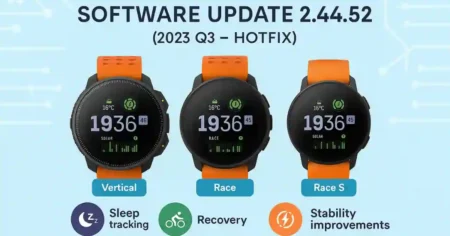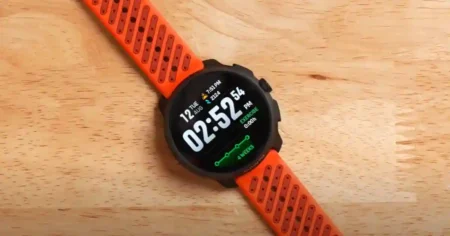Suunto has officially unveiled the Suunto Run — a $249 GPS smartwatch that strikes a solid balance between performance and price. Aimed squarely at runners, this is arguably Suunto’s most accessible sports watch in years, both in cost and ease of use.
Think of it as a streamlined sibling of the Suunto Race S, sharing many of its strengths while ditching the bells and whistles that ultra-endurance athletes might miss — like offline topo maps or power meter support.
But Suunto’s not just trimming — it’s adding. In fact, the Suunto Run introduces several firsts for the brand in this price range: offline music support (via Bluetooth headphones), outdoor track mode, hydration and nutrition reminders, a recovery widget, and more.
And yes, it still retains core essentials like structured workouts, wrist-based HR, triathlon mode, and route navigation.
For $249? That’s a pretty compelling proposition. So let’s break it down.
Price & Value: Is the $249 Suunto Run Worth It?
Alright, let’s talk money. Spending $249 on a running watch isn’t exactly pocket change—but honestly, this one gives you quite a bit for the price.
You’re getting some pretty cool features here: offline music (no phone needed, finally!), a fresh optical heart rate sensor, and an interface that’s actually pleasant to use.
It even includes things like outdoor track mode, marathon pacing tools, and little touches like hydration and nutrition reminders. Those small things really add up, especially on longer runs.
Now, is it perfect? Not quite. If you’re more into trail running or want a massive list of sport modes to choose from, you might feel a bit limited. There’s no offline topo maps, and it’s missing some of the fancier options you’d find on higher-end models.
But for most everyday runners—especially if you’re sticking to roads or treadmills—it checks a lot of boxes. It’s reliable, looks good, does what it needs to do, and doesn’t empty your wallet in the process.
Bottom line? For $249, it’s a solid deal. Not overhyped. Not underwhelming. Just a really good middle-ground option for runners who want smart features without going all-in on price.
- Premium Design & User Customized – SUUNTO Run compact sports watch features a 1.32” AMOLED touchscreen and crown design…
- 12 Days Battery Life & Fast Charging- Equipped with 12 days competitive battery life for long time daily mode use, SUUNT…
- Dual-band GPS Tracking – Keeping the superior tracking accuracy with dual bands GPS tracking and navigation, the SUUNTO …

What’s New in Suunto Run: Key Features You’ll Love
Okay, let’s get to the exciting stuff: the new features that make the Suunto Run unique.
Music Playback
First up, you can now play music directly from the watch. This isn’t a huge surprise, since Suunto’s parent company sells headphones. It makes sense to let you control the music from your wrist.
The watch has 4GB of storage for your MP3 files. Keep in mind that there’s no support for streaming services like Spotify, Amazon Music, or YouTube Music.
It sounds like that’s not coming anytime soon. You’ll have to load your own MP3s onto the watch. I will say that getting the music onto the watch is a bit slow.
Once your music is loaded, you can pair your Bluetooth headphones (like my Air Pod Pros) and start listening. The Suunto app lets you create playlists.
However, the music organization is a little clunky. It doesn’t seem to recognize folder structures. When I dragged an entire album onto the watch, it just showed me a list of all my songs.
Voice Feedback
Another cool feature is voice feedback. The watch can now send audio cues directly to your headphones without needing the Suunto app. This is great if you want to hear your lap splits, for example, even if you’re not listening to music.
New Optical Heart Rate Sensor: How Accurate Is It?
The Suunto Run has a new optical heart rate sensor on the back. If you remember, the heart rate sensor on the Suunto Race wasn’t great. This new one is better, but still “okay, but not awesome.” I’ll get into the accuracy later on.
One thing I do like is the new recovery tracking feature. For the three minutes after your workout, the watch tracks your heart rate and logs your recovery period. You can see this data in the workout summary and in the app.
Dual-Frequency GPS: A Big Deal for the Price
This is a big deal: come with multiband or dual-frequency GPS, even at its $249 price point! That’s pretty rare. More on how well that works in a bit.
Diving Deep: Accuracy and Performance
Let’s get into the details of how well the Suunto Run actually performs.
Running Track Mode
The Suunto Run has a dedicated running track mode. Other companies have a mode that learns the layout of the track as a 400-meter oval. It then gives you very accurate distance and pacing data.
The Suunto Run now has that feature. Typically, you need to run a couple of calibration laps to teach the watch the track. Then, any future runs on that track will be more accurate. After the first couple of laps, the line for that oval was perfect every single time.
You also need to tell the watch which lane you’re running in (1, 2, 3, etc.). Each lane has a different distance. Once you select your lane, the watch snaps everything to that distance. In my tests, it was spot on every time I crossed the start/finish lines.
GPS Accuracy
How accurate is the GPS in different situations?
- Trail Running: Along cliff edges and under trees, the GPS was spot-on compared to other watches. Samsung is doing a good job with both the multiband GPS and the antenna design.
- Outdoor Cycling: The GPS worked well in the mountains, including on switchbacks during both climbs and descents.
- Open Water Swimming: This is where Suunto still struggles. The Suunto Run did better than the Apple Watch Ultra 2 but not as well as a reference track. If you only swim occasionally, it’s probably fine. But frequent open water swimmers might find the tracking disappointing.
Elevation Accuracy
The Suunto Run has a barometric altimeter, and it seems to be reliable. On a mountain run, the elevation data matched other watches with barometric altimeters.
Heart Rate Accuracy
Now, let’s talk about heart rate.
- Trail Run: The heart rate tracking was consistent, even with changes in terrain.
- Track Intervals: This is where the Suunto Run struggled a bit. Compared to a chest strap and other watches, it was sometimes off. The optical heart rate sensor isn’t the best. It’s mostly acceptable, but it misses the mark sometimes.
- Indoor Trainer: I saw similar issues during an indoor cycling workout. Even with relatively steady efforts, there were some dropouts and spikes in the data.
- Outdoor Ride: The heart rate tracking was good during steady climbs. But when I started descending with short sprints, it fell apart. This isn’t unusual for optical heart rate sensors, but it’s not ideal.
Overall, the heart rate tracking is mostly fine for steady-state activities. But it becomes less reliable during interval workouts or activities with a lot of changes in intensity.
Marathon-Ready Features: Ideal for Long-Distance Runners?
If you’re training for a marathon, the Suunto Run has some features that might be helpful.
Marathon Sport Profile
The marathon sport profile estimates your finish time. If you’ve run a marathon, you know that pacing can get tricky in the later miles. This feature helps you simplify the math based on your current pace.
Hydration and Nutrition Alerts
You can set up hydration and nutrition alerts in the Suunto app. You can choose how often you want to be reminded to drink or eat. The watch will then remind you during your workout. This feature comes from the Suunto Plus apps, which is nice.
Additional Features and User Interface
The Suunto Run has a few other features worth mentioning.
Metronome
There’s a built-in metronome with both audible and vibration alerts. This is useful for cadence training.
Trending Recovery Widget
The recovery widget combines your HRV, sleep data, and training stress balance (TSB) into a single score. This gives you a quick overview of your recovery status.
Breathe Widget
The breathe widget lets you set a timer (1, 2, 3 minutes, or custom) for focused breathing and relaxation.
User Interface Walkthrough
- Watch Faces: There are eight different watch faces to choose from.
- Widgets: You can customize up to six different widgets. The control panel is always at the top, which is a bit annoying. Why are we limited to only six widgets? There are plenty of widgets available. Also, the training volume resets every Monday morning. It should be a 7-day trailing load, like most other companies do.
- Sport Profile Selection: You can access sport profiles in two ways: by pressing the upper right button (which loads the last used profile) or by tapping the middle digital crown. The digital crown method brings up a dashboard with scheduled activities, recent profiles, and all profiles. I like this dashboard; it’s well-designed and easy to use. You can also customize data pages and fields in the Suunto app.
- Navigation: The watch offers breadcrumb-style navigation with off-course alerts. You can create routes in Strava and sync them to the watch. There are no offline maps, though.
Battery Life & Charging Quirks
Battery life is acceptable but not amazing. With always-on display and about 1–2 hours of workouts per day, expect around 4 days on a single charge.
Suunto says the new “Marathon Mode” can get you through 20+ hours of GPS tracking, but for all-day endurance events, the Race or Vertical still has the edge.
Charging? Well, that’s a mixed bag. Suunto’s opted for a new USB-C cable, which feels a bit flimsy and struggles with magnetic alignment.
It’s not a deal-breaker, but it’s definitely not flagship quality. At least they’ve bundled both short and long straps in the box — a nice touch for different wrist sizes.
Everyday Experience
Using the Suunto Run daily is refreshingly simple. The interface is clean, and while customization is limited (only 6 widgets max, and no reordering the control center), navigation is fluid.
The optical heart rate sensor has been updated and performs well for daily metrics like sleep and resting HR.
Notification support is present, but far from perfect. There’s no app icon or contact name shown — just the raw message. Emojis? Hit or miss. But let’s be honest: most people aren’t buying a Suunto for smartwatch features.
Instead, it’s all about training tools. And in that regard, the Suunto Run punches well above its weight class.
What’s Missing in Suunto Run
Let’s talk about what you don’t get with the Suunto Run—because, let’s be honest, at $249, there had to be a few trade-offs.
First off, there are no offline maps. If you’re used to navigating with colorful, full-detail topo maps (like you get on the Suunto Race or Garmin Forerunner 965), that’s something to note. You still get breadcrumb navigation, which works fine for most people—it shows your path and helps you retrace your steps—but it’s not quite as helpful if you’re deep in the woods without cell signal and want a full map view.
Another missing piece? External sensor support, especially for cyclists. If you’re hoping to pair a bike power meter or cadence sensor, this watch won’t support it. Runners won’t care, but if you’re a triathlete or heavy into cycling, it might be a dealbreaker.
Also, unlike the Race and Vertical, there’s no SuuntoPlus Store, so you can’t install extra apps or data fields. That said, some of the most popular SuuntoPlus features (like Ghost Runner) now come baked in—so you’re not missing much unless you were really into customizing things.
The Suunto Run also has 34 sport modes, which is decent, but a bit shy compared to the 95+ you’d find on Suunto’s flagship watches. Still, it covers all the basics: running, cycling, swimming, strength, yoga—so unless you’re training in, say, underwater hockey, you’re probably good.
And finally—yep, the battery life is a little shorter than the premium models. But not by much. You still get up to 40 hours in GPS mode, which is more than enough for training runs, race days, and even a weekend trail adventure.
Bottom line? Suunto clearly trimmed a few extras to keep the price low, but they didn’t cut the core stuff that really matters for most runners and fitness folks.
Conclusion
So, what’s the final verdict on the Suunto Run? For $249, this is a really good deal. You get the Suunto ecosystem, including the app with its route design and training features. The watch itself has recovery tracking, training load metrics, and a wide range of sport profiles.
Most importantly, you get dual-frequency GPS at a price point that’s almost unheard of. If you’re a runner who doesn’t need offline maps or Suunto Plus apps, the Suunto Run is definitely worth considering.
Also See:- First Look: Suunto Race 2 & Vertical 2 – Specs, and Release Date







